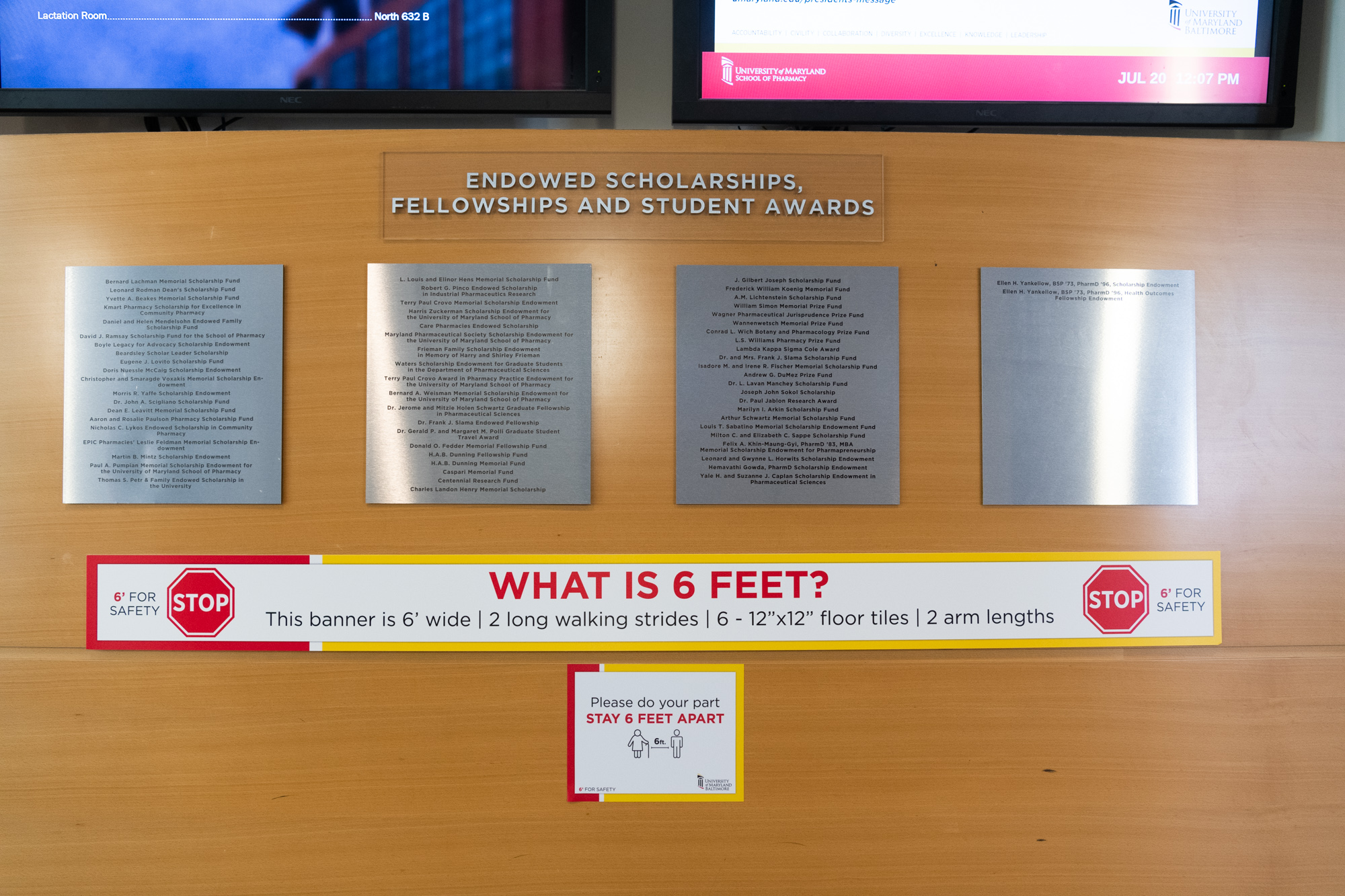COVID-19 Safety Signs Posted Throughout UMB Campus Buildings
July 29, 2020 Jen Badie
Signage on masks, physical distancing, and other measures aims to protect University community during pandemic.
“Please do your part. Stay 6 feet apart.” “Cloth masks must be worn when entering UMB buildings and in all open/public areas.” “Except in an emergency, this stairway is down only. Do not crowd.”
These are just some of the constant COVID-19 safety reminders that members of the University of Maryland, Baltimore (UMB) community will find posted at buildings when they are permitted to return to campus.
All of the red and yellow signs instruct students, faculty, staff, and visitors to stay apart “6’ for Safety.” They include guidance on the maximum number of people who should be in elevators, kitchens, and restrooms; lab rules; and hand hygiene. There are also directional signs to keep traffic flowing one way in stairwells, hallways, doorways, and labs so that people can maintain physical distancing. Schools can place footprints or arrows on floors to guide heavy traffic areas.
“Hopefully it’s going to help keep everyone safe because the signage will serve as a constant reminder of things people should be doing to reduce the spread of COVID-19,” said Dana Rampolla, assistant director of marketing, alumni communications and special projects for the University, who collaborated with the UMB Office of Environmental Health and Safety (EHS) and individual schools to develop and place the signs.
“Once the UMB Recovery Task Force was formed to develop a safe re-entry plan for returning to campus, it was decided that signs would be needed in all of our buildings,” Rampolla said. UMB Interim President Bruce E. Jarrell, MD, FACS, said in a June letter to the UMB community that while the University plans to hold lectures across all schools and programs virtually in the fall, in-person interactive classes may be held with approval and will be announced by individual deans. The University announced that it would enter Stage 1 of clinical and community-based human subjects research July 20, and Phase 2 for preclinical laboratory-based research July 27.
The signs reinforce steps that the Centers for Disease Control and Prevention has said may help prevent the spread of the novel coronavirus.
“Social distancing should be practiced in combination with other everyday preventive actions to reduce the spread of COVID-19, including wearing cloth face coverings, avoiding touching your face with unwashed hands, and frequently washing your hands with soap and water for at least 20 seconds,” according to the CDC website.
One of the starkest safety reminders on campus is a banner that is 6 feet long, giving a visual to people inside buildings. It states, “What is 6 feet?” and explains that 6 feet is two long walking strides, six 12-inch-by-12-inch floor tiles, or two arm lengths.
Pam Crowe, the School of Pharmacy’s director of facilities and laboratory services, suggested this sign as well as others be posted in “crush” spaces such as lobby entrances and the areas outside lecture halls, classrooms, and conference rooms.
“This space becomes very crowded as people wait to enter or exit the rooms. People also linger and cluster outside these rooms. Some people do not have a good sense of spatial distances,” said Crowe, who added that about 200 signs have been placed in the seven-floor Pharmacy Hall. “So it is helpful to provide a visual reference of how long 6 feet actually is, as well as a reminder that it is recommended that we stay 6 feet away from everyone.”
Department of Pharmaceutical Sciences (PSC) faculty members put up signs “because they believe it is important to adhere to physical distancing in order to safely conduct research and safely move through research spaces. PSC also posted ‘COVID-19 Safe Laboratory Practices’ signage to provide researchers with additional guidelines that would ensure a safe laboratory environment,” Crowe said.
Steve Deck, DM, MBA, EHS director and the Recovery Task Force’s University Health deputy focus area leader, said the signage is “critical to our overall strategy to promote COVID-healthy behaviors on campus.”
Deck says there are four main points of emphasis: Do not come to campus if you are sick or symptomatic; wear face coverings; practice physical distancing; and use good hand hygiene.
“This signage reinforces that message to the campus community that when you’re on this campus, we expect you to do those four things,” said Deck, whose staff helped place signs in labs so the University could move to Phase 1 of the research plan. “It’s part of our overall strategy to create a safe campus where the chance of transmitting COVID is very low.”
Individual schools are responsible for posting the COVID-19 signs based on their buildings’ needs. The UMB COVID-19 Recovery website has a sign repository called COVID-19 Digital Signage Toolbox (which can be found under the Testing, Hygiene, and Health section). Schools can order signs through vendor Image 360 or print out the signs themselves.
About two dozen types of signs in various sizes are available on the website, but Rampolla said if a school needs a sign that is not available, it can contact her to discuss creating one.
The signs are “all branded so that people will recognize the signage and how it relates to COVID-19,” she said.